Social Determinants, Epidemiology, and PHC in US: Smoking & Alcohol
VerifiedAdded on 2022/10/01
|10
|3087
|430
Report
AI Summary
This report examines the issue of smoking and excessive alcohol consumption in the United States, focusing on the practice of Primary Health Care (PHC). It explores the correlation between various Social Determinants of Health (SDHs) and substance abuse, including equity, neighborhood conditions, access to healthcare, employment, and education. The report reviews epidemiological studies conducted in the USA on alcohol and smoking, analyzing the PHC nurse's role in combating the problem, encompassing mental and physical health assessment, diagnosis and treatment, medication management, and blood-borne virus testing. Furthermore, it emphasizes the pertinence of cultural competency for PHC nurses in addressing the diverse needs of the US population, considering racial and socioeconomic factors. The report highlights the dynamic and demanding role of PHC nurses, underscoring their responsibilities in delivering comprehensive care within the complex social, political, cultural, and economic contexts of the US healthcare system.

Running Head: SMOKING AND ALCOHOL CONSUMPTION IN THE USA
Smoking and Alcohol Consumption in the USA
Institution
Student name
Date
Smoking and Alcohol Consumption in the USA
Institution
Student name
Date
Paraphrase This Document
Need a fresh take? Get an instant paraphrase of this document with our AI Paraphraser
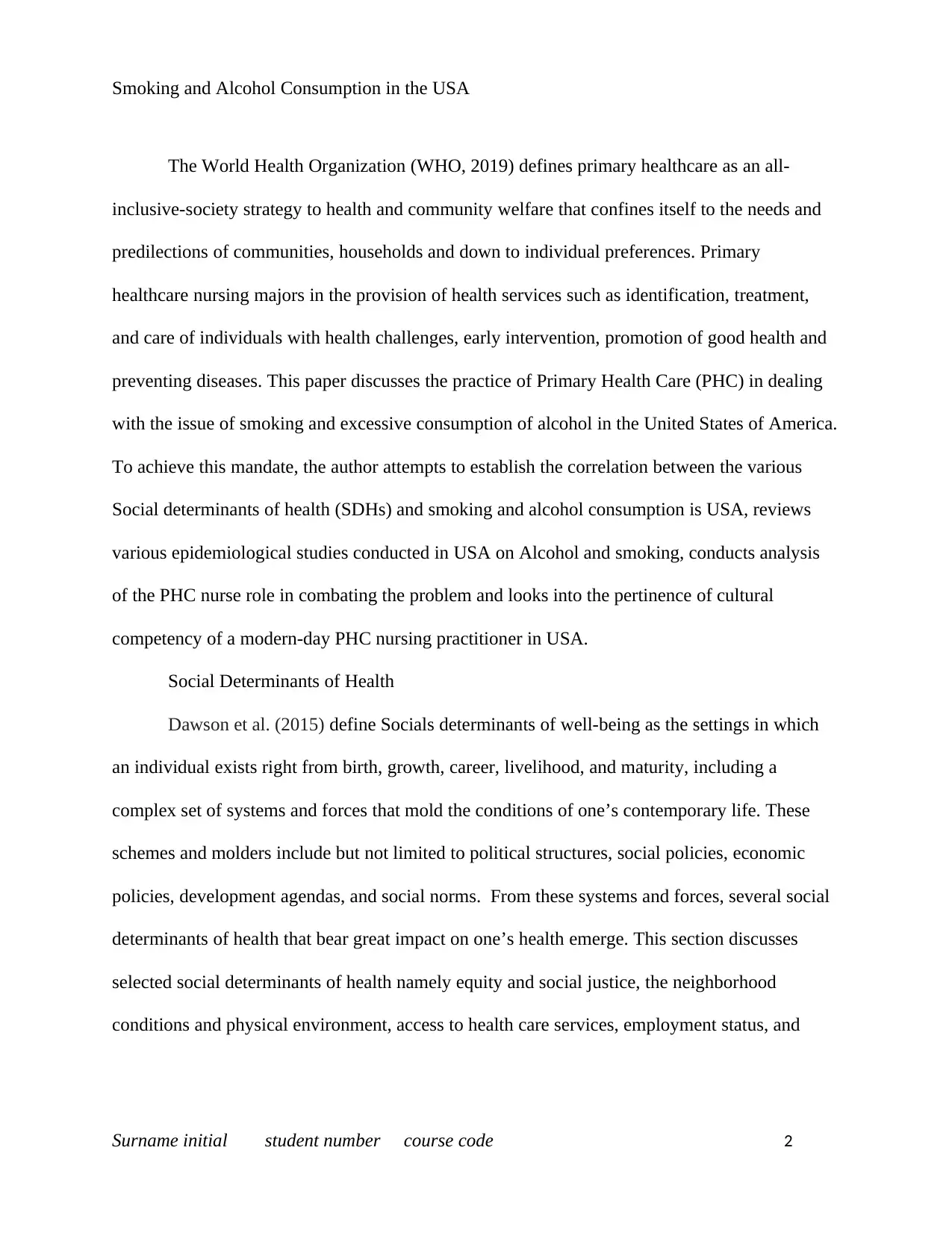
Smoking and Alcohol Consumption in the USA
The World Health Organization (WHO, 2019) defines primary healthcare as an all-
inclusive-society strategy to health and community welfare that confines itself to the needs and
predilections of communities, households and down to individual preferences. Primary
healthcare nursing majors in the provision of health services such as identification, treatment,
and care of individuals with health challenges, early intervention, promotion of good health and
preventing diseases. This paper discusses the practice of Primary Health Care (PHC) in dealing
with the issue of smoking and excessive consumption of alcohol in the United States of America.
To achieve this mandate, the author attempts to establish the correlation between the various
Social determinants of health (SDHs) and smoking and alcohol consumption is USA, reviews
various epidemiological studies conducted in USA on Alcohol and smoking, conducts analysis
of the PHC nurse role in combating the problem and looks into the pertinence of cultural
competency of a modern-day PHC nursing practitioner in USA.
Social Determinants of Health
Dawson et al. (2015) define Socials determinants of well-being as the settings in which
an individual exists right from birth, growth, career, livelihood, and maturity, including a
complex set of systems and forces that mold the conditions of one’s contemporary life. These
schemes and molders include but not limited to political structures, social policies, economic
policies, development agendas, and social norms. From these systems and forces, several social
determinants of health that bear great impact on one’s health emerge. This section discusses
selected social determinants of health namely equity and social justice, the neighborhood
conditions and physical environment, access to health care services, employment status, and
Surname initial student number course code 2
The World Health Organization (WHO, 2019) defines primary healthcare as an all-
inclusive-society strategy to health and community welfare that confines itself to the needs and
predilections of communities, households and down to individual preferences. Primary
healthcare nursing majors in the provision of health services such as identification, treatment,
and care of individuals with health challenges, early intervention, promotion of good health and
preventing diseases. This paper discusses the practice of Primary Health Care (PHC) in dealing
with the issue of smoking and excessive consumption of alcohol in the United States of America.
To achieve this mandate, the author attempts to establish the correlation between the various
Social determinants of health (SDHs) and smoking and alcohol consumption is USA, reviews
various epidemiological studies conducted in USA on Alcohol and smoking, conducts analysis
of the PHC nurse role in combating the problem and looks into the pertinence of cultural
competency of a modern-day PHC nursing practitioner in USA.
Social Determinants of Health
Dawson et al. (2015) define Socials determinants of well-being as the settings in which
an individual exists right from birth, growth, career, livelihood, and maturity, including a
complex set of systems and forces that mold the conditions of one’s contemporary life. These
schemes and molders include but not limited to political structures, social policies, economic
policies, development agendas, and social norms. From these systems and forces, several social
determinants of health that bear great impact on one’s health emerge. This section discusses
selected social determinants of health namely equity and social justice, the neighborhood
conditions and physical environment, access to health care services, employment status, and
Surname initial student number course code 2
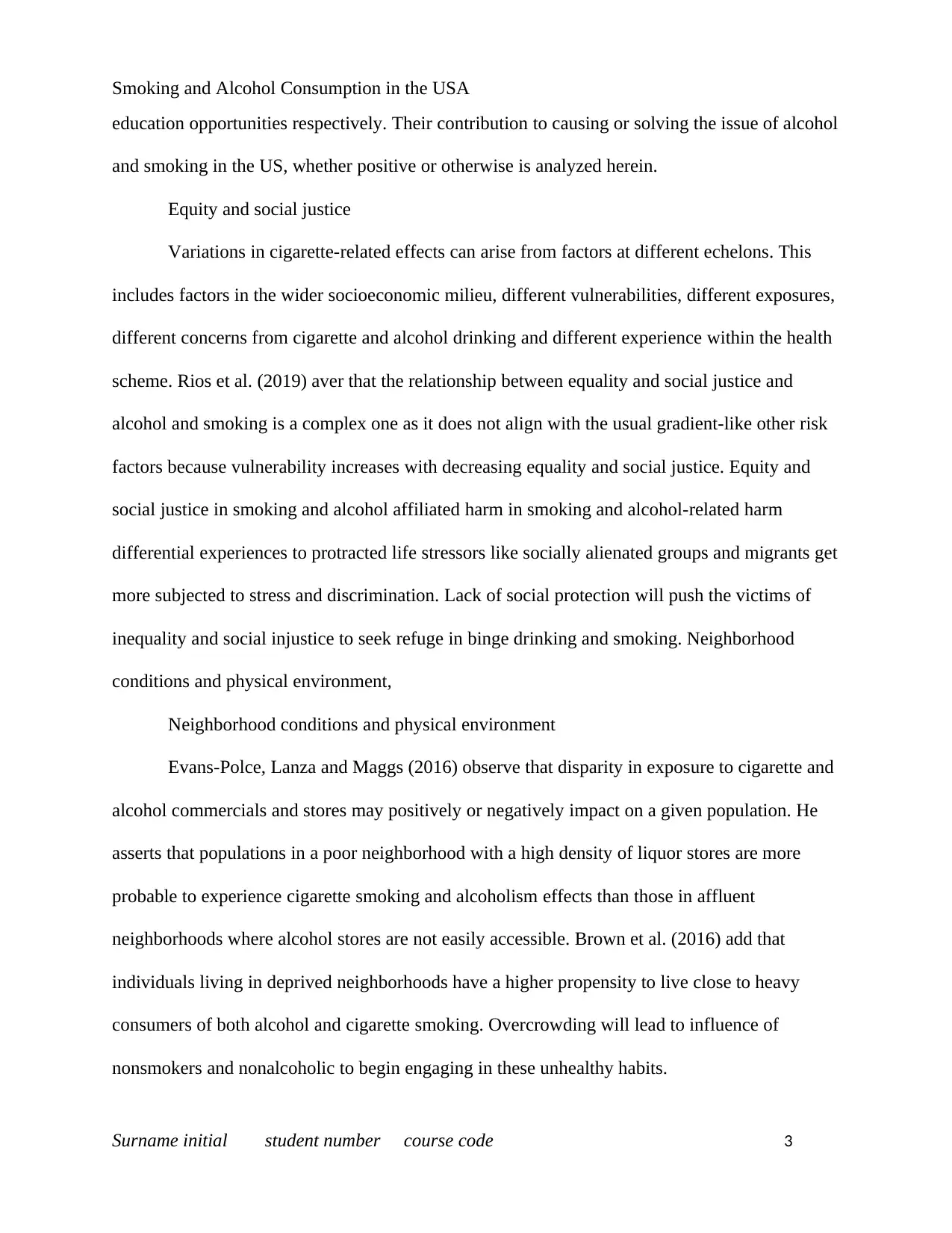
Smoking and Alcohol Consumption in the USA
education opportunities respectively. Their contribution to causing or solving the issue of alcohol
and smoking in the US, whether positive or otherwise is analyzed herein.
Equity and social justice
Variations in cigarette-related effects can arise from factors at different echelons. This
includes factors in the wider socioeconomic milieu, different vulnerabilities, different exposures,
different concerns from cigarette and alcohol drinking and different experience within the health
scheme. Rios et al. (2019) aver that the relationship between equality and social justice and
alcohol and smoking is a complex one as it does not align with the usual gradient-like other risk
factors because vulnerability increases with decreasing equality and social justice. Equity and
social justice in smoking and alcohol affiliated harm in smoking and alcohol-related harm
differential experiences to protracted life stressors like socially alienated groups and migrants get
more subjected to stress and discrimination. Lack of social protection will push the victims of
inequality and social injustice to seek refuge in binge drinking and smoking. Neighborhood
conditions and physical environment,
Neighborhood conditions and physical environment
Evans-Polce, Lanza and Maggs (2016) observe that disparity in exposure to cigarette and
alcohol commercials and stores may positively or negatively impact on a given population. He
asserts that populations in a poor neighborhood with a high density of liquor stores are more
probable to experience cigarette smoking and alcoholism effects than those in affluent
neighborhoods where alcohol stores are not easily accessible. Brown et al. (2016) add that
individuals living in deprived neighborhoods have a higher propensity to live close to heavy
consumers of both alcohol and cigarette smoking. Overcrowding will lead to influence of
nonsmokers and nonalcoholic to begin engaging in these unhealthy habits.
Surname initial student number course code 3
education opportunities respectively. Their contribution to causing or solving the issue of alcohol
and smoking in the US, whether positive or otherwise is analyzed herein.
Equity and social justice
Variations in cigarette-related effects can arise from factors at different echelons. This
includes factors in the wider socioeconomic milieu, different vulnerabilities, different exposures,
different concerns from cigarette and alcohol drinking and different experience within the health
scheme. Rios et al. (2019) aver that the relationship between equality and social justice and
alcohol and smoking is a complex one as it does not align with the usual gradient-like other risk
factors because vulnerability increases with decreasing equality and social justice. Equity and
social justice in smoking and alcohol affiliated harm in smoking and alcohol-related harm
differential experiences to protracted life stressors like socially alienated groups and migrants get
more subjected to stress and discrimination. Lack of social protection will push the victims of
inequality and social injustice to seek refuge in binge drinking and smoking. Neighborhood
conditions and physical environment,
Neighborhood conditions and physical environment
Evans-Polce, Lanza and Maggs (2016) observe that disparity in exposure to cigarette and
alcohol commercials and stores may positively or negatively impact on a given population. He
asserts that populations in a poor neighborhood with a high density of liquor stores are more
probable to experience cigarette smoking and alcoholism effects than those in affluent
neighborhoods where alcohol stores are not easily accessible. Brown et al. (2016) add that
individuals living in deprived neighborhoods have a higher propensity to live close to heavy
consumers of both alcohol and cigarette smoking. Overcrowding will lead to influence of
nonsmokers and nonalcoholic to begin engaging in these unhealthy habits.
Surname initial student number course code 3
⊘ This is a preview!⊘
Do you want full access?
Subscribe today to unlock all pages.

Trusted by 1+ million students worldwide

Smoking and Alcohol Consumption in the USA
Access to health care services
Enhancing access to primary healthcare goes a long way in enhancing access to both
short and long-term interventions to alcohol and smoking such as cessation support, provision of
referral and rehabilitation links as well as screening and treatment for mental and health issues
emanating from the habit (Evans-Polce, Lanza & Maggs, 2016). Consequently, the harder it is to
access healthcare services and support systems to cope with life stressors, the more difficult it is
for alcohol and cigar victims to quit. The US government embarked on a program to single out
the most vulnerable groups to smoking and alcohol-related effects to offer short term
interventions. There also exists a myriad of inequities in access to health care facilities and
treatment for cigarette smoking and binge drinking problems, which can also help elucidate why
some individuals are less well-off, while their hazardous alcohol consumption and cigar smoking
rates may be similar to others.
Employment status
Employment status directly reflects the economic status of and individual. Studies show
that the effects and vulnerability of alcohol and smoking harm increase with decreasing
economic status thus making the unemployed group more vulnerable as compared to their
employed counterparts. Blue, Shove, Carmona and Kelly (2016) advise that it is, therefore,
paramount to keep in mind the type of alcohol and cigarettes consumed, frequency of use, prices
of the products and both the positive and negative factors when addressing the issue of alcohol
and smoking among the unemployed in the US. It is against this background that the US
government in its tobacco and alcohol intervention strategy chose to adopt the 5A framework
which stands for accessibility, accountability, affordability, availability which basically makes it
difficult for the most vulnerable groups to access and use tobacco and alcohol. At individual
Surname initial student number course code 4
Access to health care services
Enhancing access to primary healthcare goes a long way in enhancing access to both
short and long-term interventions to alcohol and smoking such as cessation support, provision of
referral and rehabilitation links as well as screening and treatment for mental and health issues
emanating from the habit (Evans-Polce, Lanza & Maggs, 2016). Consequently, the harder it is to
access healthcare services and support systems to cope with life stressors, the more difficult it is
for alcohol and cigar victims to quit. The US government embarked on a program to single out
the most vulnerable groups to smoking and alcohol-related effects to offer short term
interventions. There also exists a myriad of inequities in access to health care facilities and
treatment for cigarette smoking and binge drinking problems, which can also help elucidate why
some individuals are less well-off, while their hazardous alcohol consumption and cigar smoking
rates may be similar to others.
Employment status
Employment status directly reflects the economic status of and individual. Studies show
that the effects and vulnerability of alcohol and smoking harm increase with decreasing
economic status thus making the unemployed group more vulnerable as compared to their
employed counterparts. Blue, Shove, Carmona and Kelly (2016) advise that it is, therefore,
paramount to keep in mind the type of alcohol and cigarettes consumed, frequency of use, prices
of the products and both the positive and negative factors when addressing the issue of alcohol
and smoking among the unemployed in the US. It is against this background that the US
government in its tobacco and alcohol intervention strategy chose to adopt the 5A framework
which stands for accessibility, accountability, affordability, availability which basically makes it
difficult for the most vulnerable groups to access and use tobacco and alcohol. At individual
Surname initial student number course code 4
Paraphrase This Document
Need a fresh take? Get an instant paraphrase of this document with our AI Paraphraser
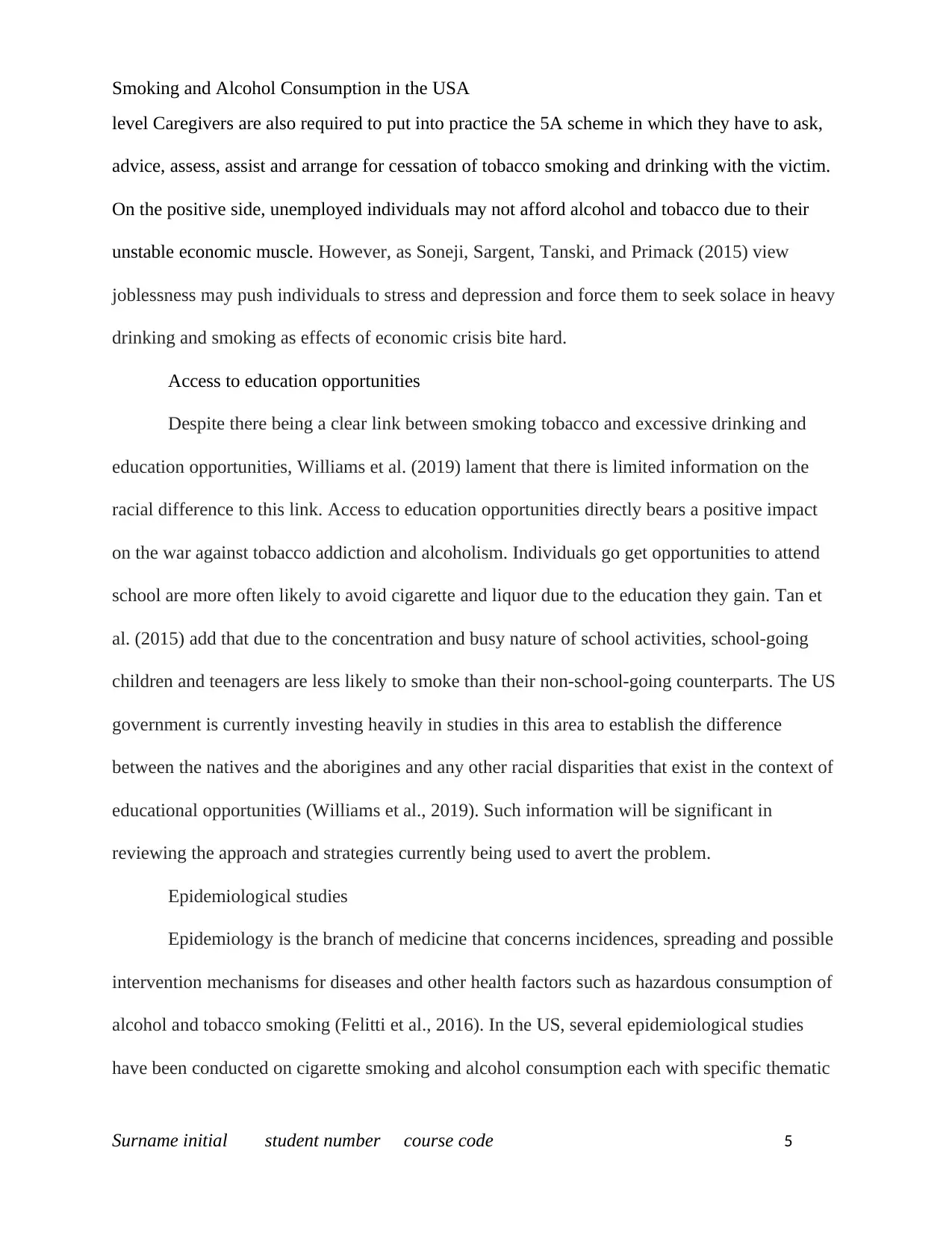
Smoking and Alcohol Consumption in the USA
level Caregivers are also required to put into practice the 5A scheme in which they have to ask,
advice, assess, assist and arrange for cessation of tobacco smoking and drinking with the victim.
On the positive side, unemployed individuals may not afford alcohol and tobacco due to their
unstable economic muscle. However, as Soneji, Sargent, Tanski, and Primack (2015) view
joblessness may push individuals to stress and depression and force them to seek solace in heavy
drinking and smoking as effects of economic crisis bite hard.
Access to education opportunities
Despite there being a clear link between smoking tobacco and excessive drinking and
education opportunities, Williams et al. (2019) lament that there is limited information on the
racial difference to this link. Access to education opportunities directly bears a positive impact
on the war against tobacco addiction and alcoholism. Individuals go get opportunities to attend
school are more often likely to avoid cigarette and liquor due to the education they gain. Tan et
al. (2015) add that due to the concentration and busy nature of school activities, school-going
children and teenagers are less likely to smoke than their non-school-going counterparts. The US
government is currently investing heavily in studies in this area to establish the difference
between the natives and the aborigines and any other racial disparities that exist in the context of
educational opportunities (Williams et al., 2019). Such information will be significant in
reviewing the approach and strategies currently being used to avert the problem.
Epidemiological studies
Epidemiology is the branch of medicine that concerns incidences, spreading and possible
intervention mechanisms for diseases and other health factors such as hazardous consumption of
alcohol and tobacco smoking (Felitti et al., 2016). In the US, several epidemiological studies
have been conducted on cigarette smoking and alcohol consumption each with specific thematic
Surname initial student number course code 5
level Caregivers are also required to put into practice the 5A scheme in which they have to ask,
advice, assess, assist and arrange for cessation of tobacco smoking and drinking with the victim.
On the positive side, unemployed individuals may not afford alcohol and tobacco due to their
unstable economic muscle. However, as Soneji, Sargent, Tanski, and Primack (2015) view
joblessness may push individuals to stress and depression and force them to seek solace in heavy
drinking and smoking as effects of economic crisis bite hard.
Access to education opportunities
Despite there being a clear link between smoking tobacco and excessive drinking and
education opportunities, Williams et al. (2019) lament that there is limited information on the
racial difference to this link. Access to education opportunities directly bears a positive impact
on the war against tobacco addiction and alcoholism. Individuals go get opportunities to attend
school are more often likely to avoid cigarette and liquor due to the education they gain. Tan et
al. (2015) add that due to the concentration and busy nature of school activities, school-going
children and teenagers are less likely to smoke than their non-school-going counterparts. The US
government is currently investing heavily in studies in this area to establish the difference
between the natives and the aborigines and any other racial disparities that exist in the context of
educational opportunities (Williams et al., 2019). Such information will be significant in
reviewing the approach and strategies currently being used to avert the problem.
Epidemiological studies
Epidemiology is the branch of medicine that concerns incidences, spreading and possible
intervention mechanisms for diseases and other health factors such as hazardous consumption of
alcohol and tobacco smoking (Felitti et al., 2016). In the US, several epidemiological studies
have been conducted on cigarette smoking and alcohol consumption each with specific thematic
Surname initial student number course code 5
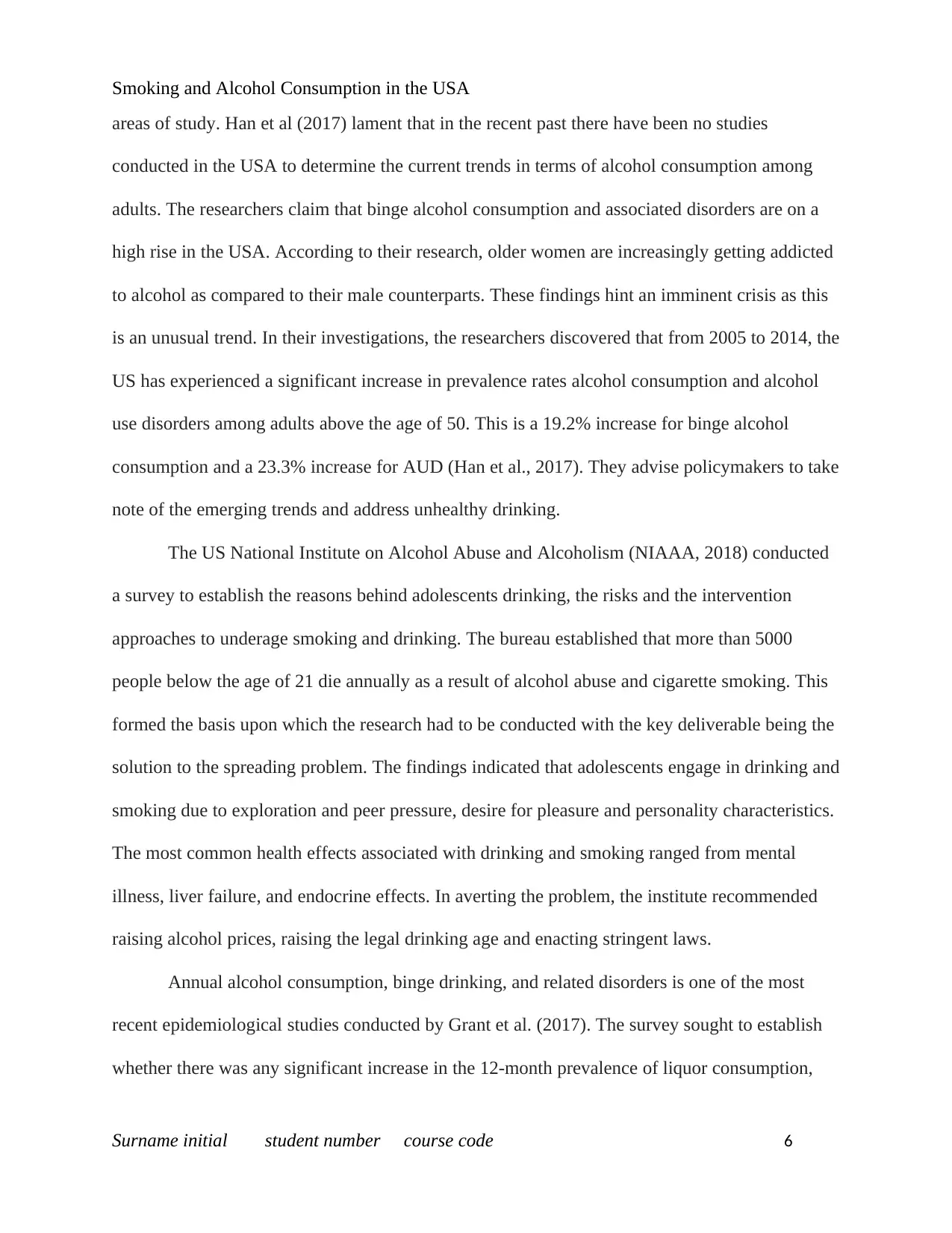
Smoking and Alcohol Consumption in the USA
areas of study. Han et al (2017) lament that in the recent past there have been no studies
conducted in the USA to determine the current trends in terms of alcohol consumption among
adults. The researchers claim that binge alcohol consumption and associated disorders are on a
high rise in the USA. According to their research, older women are increasingly getting addicted
to alcohol as compared to their male counterparts. These findings hint an imminent crisis as this
is an unusual trend. In their investigations, the researchers discovered that from 2005 to 2014, the
US has experienced a significant increase in prevalence rates alcohol consumption and alcohol
use disorders among adults above the age of 50. This is a 19.2% increase for binge alcohol
consumption and a 23.3% increase for AUD (Han et al., 2017). They advise policymakers to take
note of the emerging trends and address unhealthy drinking.
The US National Institute on Alcohol Abuse and Alcoholism (NIAAA, 2018) conducted
a survey to establish the reasons behind adolescents drinking, the risks and the intervention
approaches to underage smoking and drinking. The bureau established that more than 5000
people below the age of 21 die annually as a result of alcohol abuse and cigarette smoking. This
formed the basis upon which the research had to be conducted with the key deliverable being the
solution to the spreading problem. The findings indicated that adolescents engage in drinking and
smoking due to exploration and peer pressure, desire for pleasure and personality characteristics.
The most common health effects associated with drinking and smoking ranged from mental
illness, liver failure, and endocrine effects. In averting the problem, the institute recommended
raising alcohol prices, raising the legal drinking age and enacting stringent laws.
Annual alcohol consumption, binge drinking, and related disorders is one of the most
recent epidemiological studies conducted by Grant et al. (2017). The survey sought to establish
whether there was any significant increase in the 12-month prevalence of liquor consumption,
Surname initial student number course code 6
areas of study. Han et al (2017) lament that in the recent past there have been no studies
conducted in the USA to determine the current trends in terms of alcohol consumption among
adults. The researchers claim that binge alcohol consumption and associated disorders are on a
high rise in the USA. According to their research, older women are increasingly getting addicted
to alcohol as compared to their male counterparts. These findings hint an imminent crisis as this
is an unusual trend. In their investigations, the researchers discovered that from 2005 to 2014, the
US has experienced a significant increase in prevalence rates alcohol consumption and alcohol
use disorders among adults above the age of 50. This is a 19.2% increase for binge alcohol
consumption and a 23.3% increase for AUD (Han et al., 2017). They advise policymakers to take
note of the emerging trends and address unhealthy drinking.
The US National Institute on Alcohol Abuse and Alcoholism (NIAAA, 2018) conducted
a survey to establish the reasons behind adolescents drinking, the risks and the intervention
approaches to underage smoking and drinking. The bureau established that more than 5000
people below the age of 21 die annually as a result of alcohol abuse and cigarette smoking. This
formed the basis upon which the research had to be conducted with the key deliverable being the
solution to the spreading problem. The findings indicated that adolescents engage in drinking and
smoking due to exploration and peer pressure, desire for pleasure and personality characteristics.
The most common health effects associated with drinking and smoking ranged from mental
illness, liver failure, and endocrine effects. In averting the problem, the institute recommended
raising alcohol prices, raising the legal drinking age and enacting stringent laws.
Annual alcohol consumption, binge drinking, and related disorders is one of the most
recent epidemiological studies conducted by Grant et al. (2017). The survey sought to establish
whether there was any significant increase in the 12-month prevalence of liquor consumption,
Surname initial student number course code 6
⊘ This is a preview!⊘
Do you want full access?
Subscribe today to unlock all pages.

Trusted by 1+ million students worldwide
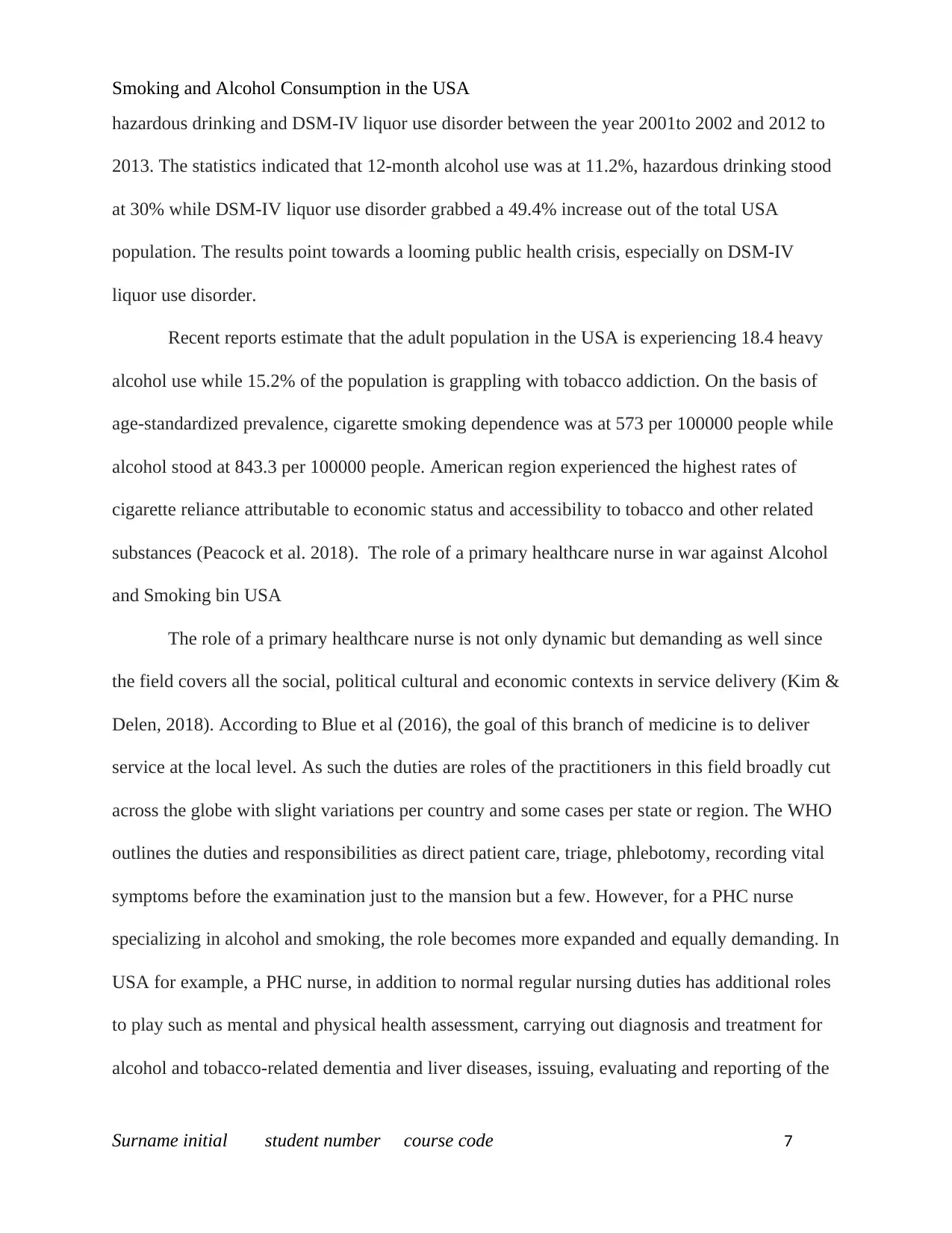
Smoking and Alcohol Consumption in the USA
hazardous drinking and DSM-IV liquor use disorder between the year 2001to 2002 and 2012 to
2013. The statistics indicated that 12-month alcohol use was at 11.2%, hazardous drinking stood
at 30% while DSM-IV liquor use disorder grabbed a 49.4% increase out of the total USA
population. The results point towards a looming public health crisis, especially on DSM-IV
liquor use disorder.
Recent reports estimate that the adult population in the USA is experiencing 18.4 heavy
alcohol use while 15.2% of the population is grappling with tobacco addiction. On the basis of
age-standardized prevalence, cigarette smoking dependence was at 573 per 100000 people while
alcohol stood at 843.3 per 100000 people. American region experienced the highest rates of
cigarette reliance attributable to economic status and accessibility to tobacco and other related
substances (Peacock et al. 2018). The role of a primary healthcare nurse in war against Alcohol
and Smoking bin USA
The role of a primary healthcare nurse is not only dynamic but demanding as well since
the field covers all the social, political cultural and economic contexts in service delivery (Kim &
Delen, 2018). According to Blue et al (2016), the goal of this branch of medicine is to deliver
service at the local level. As such the duties are roles of the practitioners in this field broadly cut
across the globe with slight variations per country and some cases per state or region. The WHO
outlines the duties and responsibilities as direct patient care, triage, phlebotomy, recording vital
symptoms before the examination just to the mansion but a few. However, for a PHC nurse
specializing in alcohol and smoking, the role becomes more expanded and equally demanding. In
USA for example, a PHC nurse, in addition to normal regular nursing duties has additional roles
to play such as mental and physical health assessment, carrying out diagnosis and treatment for
alcohol and tobacco-related dementia and liver diseases, issuing, evaluating and reporting of the
Surname initial student number course code 7
hazardous drinking and DSM-IV liquor use disorder between the year 2001to 2002 and 2012 to
2013. The statistics indicated that 12-month alcohol use was at 11.2%, hazardous drinking stood
at 30% while DSM-IV liquor use disorder grabbed a 49.4% increase out of the total USA
population. The results point towards a looming public health crisis, especially on DSM-IV
liquor use disorder.
Recent reports estimate that the adult population in the USA is experiencing 18.4 heavy
alcohol use while 15.2% of the population is grappling with tobacco addiction. On the basis of
age-standardized prevalence, cigarette smoking dependence was at 573 per 100000 people while
alcohol stood at 843.3 per 100000 people. American region experienced the highest rates of
cigarette reliance attributable to economic status and accessibility to tobacco and other related
substances (Peacock et al. 2018). The role of a primary healthcare nurse in war against Alcohol
and Smoking bin USA
The role of a primary healthcare nurse is not only dynamic but demanding as well since
the field covers all the social, political cultural and economic contexts in service delivery (Kim &
Delen, 2018). According to Blue et al (2016), the goal of this branch of medicine is to deliver
service at the local level. As such the duties are roles of the practitioners in this field broadly cut
across the globe with slight variations per country and some cases per state or region. The WHO
outlines the duties and responsibilities as direct patient care, triage, phlebotomy, recording vital
symptoms before the examination just to the mansion but a few. However, for a PHC nurse
specializing in alcohol and smoking, the role becomes more expanded and equally demanding. In
USA for example, a PHC nurse, in addition to normal regular nursing duties has additional roles
to play such as mental and physical health assessment, carrying out diagnosis and treatment for
alcohol and tobacco-related dementia and liver diseases, issuing, evaluating and reporting of the
Surname initial student number course code 7
Paraphrase This Document
Need a fresh take? Get an instant paraphrase of this document with our AI Paraphraser
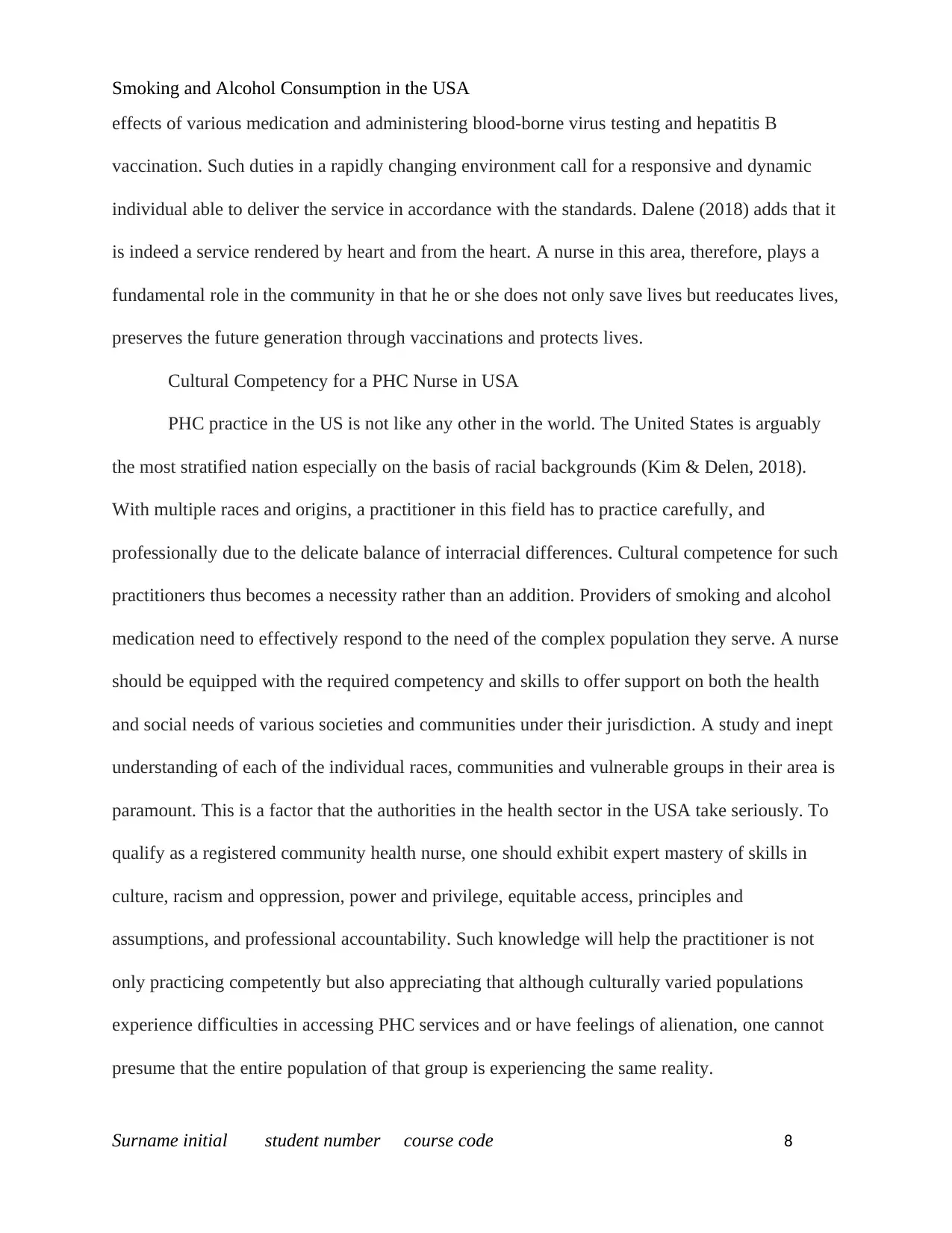
Smoking and Alcohol Consumption in the USA
effects of various medication and administering blood-borne virus testing and hepatitis B
vaccination. Such duties in a rapidly changing environment call for a responsive and dynamic
individual able to deliver the service in accordance with the standards. Dalene (2018) adds that it
is indeed a service rendered by heart and from the heart. A nurse in this area, therefore, plays a
fundamental role in the community in that he or she does not only save lives but reeducates lives,
preserves the future generation through vaccinations and protects lives.
Cultural Competency for a PHC Nurse in USA
PHC practice in the US is not like any other in the world. The United States is arguably
the most stratified nation especially on the basis of racial backgrounds (Kim & Delen, 2018).
With multiple races and origins, a practitioner in this field has to practice carefully, and
professionally due to the delicate balance of interracial differences. Cultural competence for such
practitioners thus becomes a necessity rather than an addition. Providers of smoking and alcohol
medication need to effectively respond to the need of the complex population they serve. A nurse
should be equipped with the required competency and skills to offer support on both the health
and social needs of various societies and communities under their jurisdiction. A study and inept
understanding of each of the individual races, communities and vulnerable groups in their area is
paramount. This is a factor that the authorities in the health sector in the USA take seriously. To
qualify as a registered community health nurse, one should exhibit expert mastery of skills in
culture, racism and oppression, power and privilege, equitable access, principles and
assumptions, and professional accountability. Such knowledge will help the practitioner is not
only practicing competently but also appreciating that although culturally varied populations
experience difficulties in accessing PHC services and or have feelings of alienation, one cannot
presume that the entire population of that group is experiencing the same reality.
Surname initial student number course code 8
effects of various medication and administering blood-borne virus testing and hepatitis B
vaccination. Such duties in a rapidly changing environment call for a responsive and dynamic
individual able to deliver the service in accordance with the standards. Dalene (2018) adds that it
is indeed a service rendered by heart and from the heart. A nurse in this area, therefore, plays a
fundamental role in the community in that he or she does not only save lives but reeducates lives,
preserves the future generation through vaccinations and protects lives.
Cultural Competency for a PHC Nurse in USA
PHC practice in the US is not like any other in the world. The United States is arguably
the most stratified nation especially on the basis of racial backgrounds (Kim & Delen, 2018).
With multiple races and origins, a practitioner in this field has to practice carefully, and
professionally due to the delicate balance of interracial differences. Cultural competence for such
practitioners thus becomes a necessity rather than an addition. Providers of smoking and alcohol
medication need to effectively respond to the need of the complex population they serve. A nurse
should be equipped with the required competency and skills to offer support on both the health
and social needs of various societies and communities under their jurisdiction. A study and inept
understanding of each of the individual races, communities and vulnerable groups in their area is
paramount. This is a factor that the authorities in the health sector in the USA take seriously. To
qualify as a registered community health nurse, one should exhibit expert mastery of skills in
culture, racism and oppression, power and privilege, equitable access, principles and
assumptions, and professional accountability. Such knowledge will help the practitioner is not
only practicing competently but also appreciating that although culturally varied populations
experience difficulties in accessing PHC services and or have feelings of alienation, one cannot
presume that the entire population of that group is experiencing the same reality.
Surname initial student number course code 8
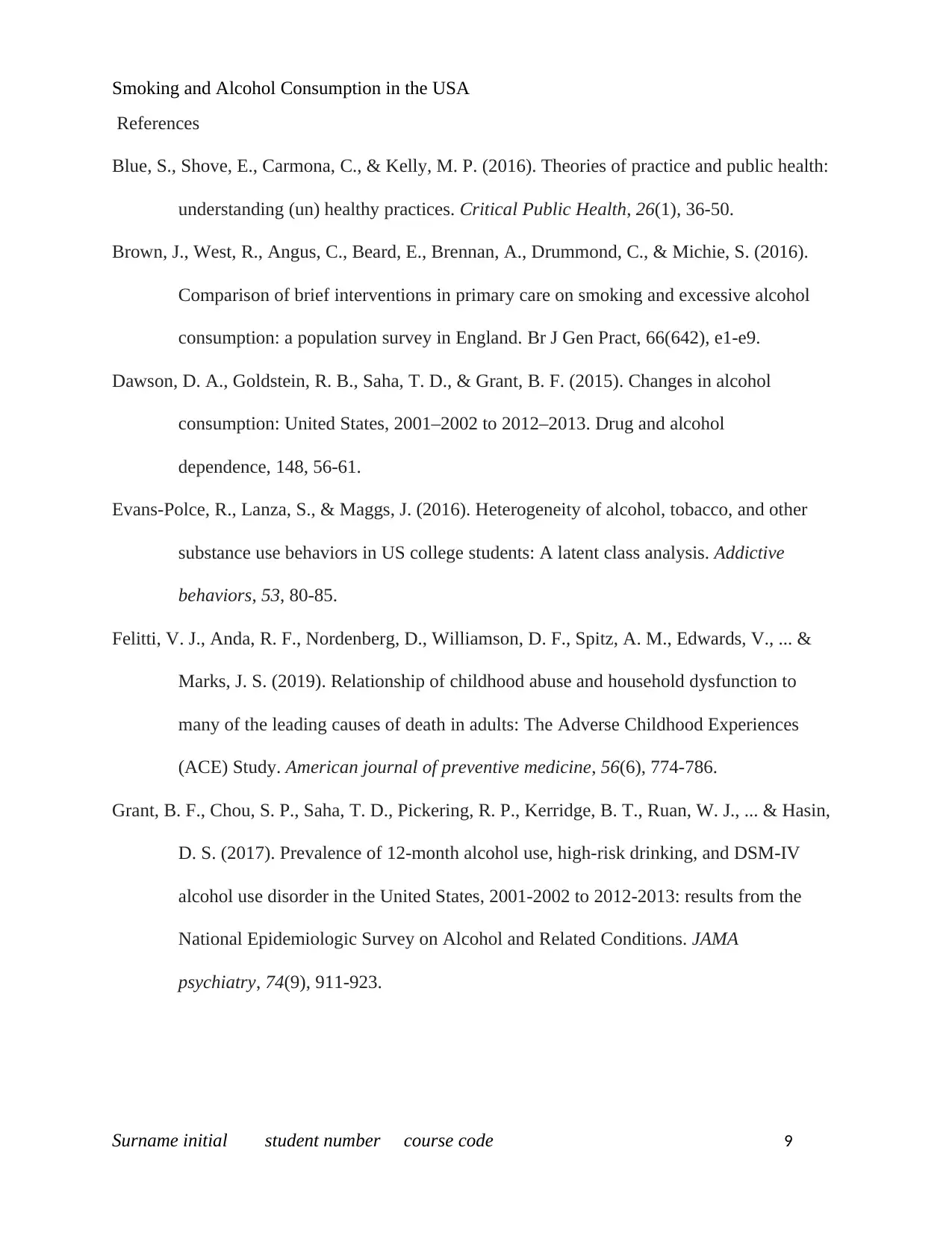
Smoking and Alcohol Consumption in the USA
References
Blue, S., Shove, E., Carmona, C., & Kelly, M. P. (2016). Theories of practice and public health:
understanding (un) healthy practices. Critical Public Health, 26(1), 36-50.
Brown, J., West, R., Angus, C., Beard, E., Brennan, A., Drummond, C., & Michie, S. (2016).
Comparison of brief interventions in primary care on smoking and excessive alcohol
consumption: a population survey in England. Br J Gen Pract, 66(642), e1-e9.
Dawson, D. A., Goldstein, R. B., Saha, T. D., & Grant, B. F. (2015). Changes in alcohol
consumption: United States, 2001–2002 to 2012–2013. Drug and alcohol
dependence, 148, 56-61.
Evans-Polce, R., Lanza, S., & Maggs, J. (2016). Heterogeneity of alcohol, tobacco, and other
substance use behaviors in US college students: A latent class analysis. Addictive
behaviors, 53, 80-85.
Felitti, V. J., Anda, R. F., Nordenberg, D., Williamson, D. F., Spitz, A. M., Edwards, V., ... &
Marks, J. S. (2019). Relationship of childhood abuse and household dysfunction to
many of the leading causes of death in adults: The Adverse Childhood Experiences
(ACE) Study. American journal of preventive medicine, 56(6), 774-786.
Grant, B. F., Chou, S. P., Saha, T. D., Pickering, R. P., Kerridge, B. T., Ruan, W. J., ... & Hasin,
D. S. (2017). Prevalence of 12-month alcohol use, high-risk drinking, and DSM-IV
alcohol use disorder in the United States, 2001-2002 to 2012-2013: results from the
National Epidemiologic Survey on Alcohol and Related Conditions. JAMA
psychiatry, 74(9), 911-923.
Surname initial student number course code 9
References
Blue, S., Shove, E., Carmona, C., & Kelly, M. P. (2016). Theories of practice and public health:
understanding (un) healthy practices. Critical Public Health, 26(1), 36-50.
Brown, J., West, R., Angus, C., Beard, E., Brennan, A., Drummond, C., & Michie, S. (2016).
Comparison of brief interventions in primary care on smoking and excessive alcohol
consumption: a population survey in England. Br J Gen Pract, 66(642), e1-e9.
Dawson, D. A., Goldstein, R. B., Saha, T. D., & Grant, B. F. (2015). Changes in alcohol
consumption: United States, 2001–2002 to 2012–2013. Drug and alcohol
dependence, 148, 56-61.
Evans-Polce, R., Lanza, S., & Maggs, J. (2016). Heterogeneity of alcohol, tobacco, and other
substance use behaviors in US college students: A latent class analysis. Addictive
behaviors, 53, 80-85.
Felitti, V. J., Anda, R. F., Nordenberg, D., Williamson, D. F., Spitz, A. M., Edwards, V., ... &
Marks, J. S. (2019). Relationship of childhood abuse and household dysfunction to
many of the leading causes of death in adults: The Adverse Childhood Experiences
(ACE) Study. American journal of preventive medicine, 56(6), 774-786.
Grant, B. F., Chou, S. P., Saha, T. D., Pickering, R. P., Kerridge, B. T., Ruan, W. J., ... & Hasin,
D. S. (2017). Prevalence of 12-month alcohol use, high-risk drinking, and DSM-IV
alcohol use disorder in the United States, 2001-2002 to 2012-2013: results from the
National Epidemiologic Survey on Alcohol and Related Conditions. JAMA
psychiatry, 74(9), 911-923.
Surname initial student number course code 9
⊘ This is a preview!⊘
Do you want full access?
Subscribe today to unlock all pages.

Trusted by 1+ million students worldwide

Smoking and Alcohol Consumption in the USA
Han, B. H., Moore, A. A., Sherman, S., Keyes, K. M., & Palamar, J. J. (2017). Demographic
trends of binge alcohol use and alcohol use disorders among older adults in the United
States, 2005–2014. Drug and alcohol dependence, 170, 198-207.
Kim, Y. M., & Delen, D. (2018). Critical assessment of health disparities across subpopulation
groups through a social determinants of health perspective: The case of type 2 diabetes
patients. Informatics for Health and Social Care, 43(2), 172-185.
Peacock, A., Leung, J., Larney, S., Colledge, S., Hickman, M., Rehm, J., ... & Ali, R. (2018).
Global statistics on alcohol, tobacco and illicit drug use: 2017 status
report. Addiction, 113(10), 1905-1926.
Soneji, S., Sargent, J. D., Tanski, S. E., & Primack, B. A. (2015). Associations between initial
water pipe tobacco smoking and snus use and subsequent cigarette smoking: results
from a longitudinal study of US adolescents and young adults. JAMA pediatrics, 169(2),
129-136.
Tan, C. H., Denny, C. H., Cheal, N. E., Sniezek, J. E., & Kanny, D. (2015). Alcohol use and
binge drinking among women of childbearing age—United States, 2011–
2013. Morbidity and Mortality Weekly Report, 64(37), 1042-1046.
Williams, N., Bossert, N., Chen, Y., Jaanimägi, U., Markatou, M., & Talal, A. H. (2019).
Influence of social determinants of health and substance use characteristics on persons
who use drugs pursuit of care for hepatitis C virus infection. Journal of substance abuse
treatment, 102, 33-39.
Surname initial student number course code 10
Han, B. H., Moore, A. A., Sherman, S., Keyes, K. M., & Palamar, J. J. (2017). Demographic
trends of binge alcohol use and alcohol use disorders among older adults in the United
States, 2005–2014. Drug and alcohol dependence, 170, 198-207.
Kim, Y. M., & Delen, D. (2018). Critical assessment of health disparities across subpopulation
groups through a social determinants of health perspective: The case of type 2 diabetes
patients. Informatics for Health and Social Care, 43(2), 172-185.
Peacock, A., Leung, J., Larney, S., Colledge, S., Hickman, M., Rehm, J., ... & Ali, R. (2018).
Global statistics on alcohol, tobacco and illicit drug use: 2017 status
report. Addiction, 113(10), 1905-1926.
Soneji, S., Sargent, J. D., Tanski, S. E., & Primack, B. A. (2015). Associations between initial
water pipe tobacco smoking and snus use and subsequent cigarette smoking: results
from a longitudinal study of US adolescents and young adults. JAMA pediatrics, 169(2),
129-136.
Tan, C. H., Denny, C. H., Cheal, N. E., Sniezek, J. E., & Kanny, D. (2015). Alcohol use and
binge drinking among women of childbearing age—United States, 2011–
2013. Morbidity and Mortality Weekly Report, 64(37), 1042-1046.
Williams, N., Bossert, N., Chen, Y., Jaanimägi, U., Markatou, M., & Talal, A. H. (2019).
Influence of social determinants of health and substance use characteristics on persons
who use drugs pursuit of care for hepatitis C virus infection. Journal of substance abuse
treatment, 102, 33-39.
Surname initial student number course code 10
1 out of 10
Related Documents
Your All-in-One AI-Powered Toolkit for Academic Success.
+13062052269
info@desklib.com
Available 24*7 on WhatsApp / Email
![[object Object]](/_next/static/media/star-bottom.7253800d.svg)
Unlock your academic potential
Copyright © 2020–2025 A2Z Services. All Rights Reserved. Developed and managed by ZUCOL.





